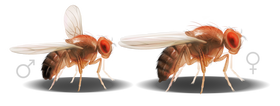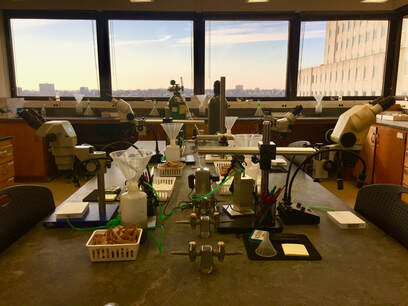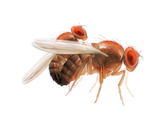Sexual Selection and Sexual Conflict in Drosophila
|
Our research uses the fruit fly model system, Drosophila melanogaster, to examine the evolutionary and genetic causes and consequences of sexual selection and sexual conflict. We study interactions between males and females using an integrative approach, drawing from the fields of animal behavior, evolutionary biology and genetics.
Our research spans all levels of sexual interactions, from finding and choosing a mate, to producing offspring, to the reproductive success of those offspring. |
Current Projects
Male Mate Choice

Females are often though of as the "choosy" sex, but there is increasing evidence in Drosophila and a number of other species that males can also be choosy if given the chance. This recognition that males also discriminate potential mating partners leads to many unanswered questions about male mate choice. What types of females do males prefer? How do males evaluate female "quality"? What are the evolutionary consequences of these male preferences? We're currently investigating these and other questions, building on our previous work on male mate choice:
|
Mating Duration and Cryptic Male Mate Choice
Sexual Conflict and Male Fitness
|
One of the consequences of having two sexes is that traits that make an "ideal" male are often different than those that make an "ideal" female. However, each sex is not free to evolve these traits independently, since males and females share largely the same genome. As a result, genetic variation that benefits one sex can actually be costly to the other, a phenomenon known as "intralocus sexual conflict". We study intralocus sexual conflict using hemiclonal analysis, a powerful genetic tool that enables us to experimentally clone haploid genotypes and express them in both sexes. We are building on our past work to pursue the following questions: How does this sexual conflict impact male and female fitness? What behaviors/traits that are beneficial to males are costly to females?
|
Previous Research
Sexual SelectionSexual selection occurs when individuals of one sex (usually males) compete for access to individuals of the opposite sex (usually females) and their gametes. Sexual selection influences which males successfully reproduce, and as a result has implications for a population's genetic variability and ability to evolve. We have used fruit flies to ask fundamental questions about sexual selection, including:
|
Male Mate ChoiceEven though females are usually considered the choosier sex, we now know that males can be discriminating about their mating partners as well. Male mate choice can occur between females of the same species, and can also play a role in preventing breeding between individuals of different species. Previous lines of investigation include:
|
Interlocus Sexual ConflictSexual conflict occurs whenever males and females have divergent reproductive interests. Interlocus sexual conflict occurs when the optimal outcome of sexual interactions is different for males and females, and results in each sex evolving adaptations that increase their own fitness but are harmful to their mates. We have studied the consequences of this conflict at the population level, and the specific traits and behaviors involved. Past questions include:
|
Intralocus Sexual ConflictIntralocus sexual conflict occurs when a genetic variant that is expressed in both sexes has opposite effects on male and female fitness (i.e. genotypes that create "high quality" males can create "low quality" females, and vice versa). We have looked at how this conflict affects males, females, and their offspring, and whether it can resolved. Previous questions include:
|
Evolutionary Genetics & Genomics
|
Much of our research examines the genetic consequences of sexual selection and sexual conflict, with a focus on how these processes affect genetic variation in populations. We have also used evolutionary genomic approaches to map behavioral variation within D. melanogaster and between Drosophila species. We have used publicly available genetic resources to ask the following questions:
|

